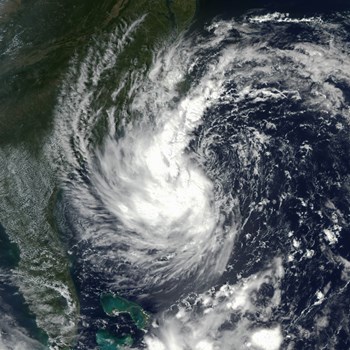
As Hurricane Wilma churned across southeast Florida on October 24, 2005, four maverick residents of a coastal Pompano Beach condominium under a mandatory evacuation order opted to stay. They brought along some booze, broke into the office, turned on the electricity (which the board of directors had turned off), and took out some pool furniture for a party.
The building itself was not heavily damaged and no one was injured, but that incident prompted new language in the Florida emergency-powers law, reports attorney Donna DiMaggio Berger. She is managing partner at Katzman Garfinkel & Berger (KG&B), a statewide firm specializing in condominium law; and executive director of the Community Advocacy Network (CAN), which lobbies in Tallahassee for positive community-association legislation.
“The statute now says that if people stay after the board of a condominium association issues a mandatory evacuation order, it’s at their own risk,” Berger explains.
While that’s an improvement, “there is no statutory requirement for a community to have a hurricane plan or preparedness guidelines or standard operating procedures,” says Bill Worrall, corporate vice president of The Continental Group (TCG) in Hollywood. The largest manager of condominium and homeowner associations in Florida, TCG manages and maintains 1,500 associations and more than 310,000 residential units.
“We do hurricane planning proactively as a community manager,” Worrall says. “For us it’s service delivery, it’s a minimum expectation and obligation to assist our clients in the protection of their assets and their properties. The board makes the final decisions and we respect that, but it’s our job to bring best practices and communication tools to our clients, and then to implement them.”
Seeking Plan Legislation
Berger says KG&B and its Community Advocacy Network (CAN) have been seeking legislation to require all residential communities to write such plans and conduct drills so everyone—board members, managers, staff, and residents—will know what to do when a storm threatens.
“Boards need to have an emergency plan and revisit it at least twice a year to see what needs to be upgraded,” Berger says. “We have 50,000 owners’ associations in the state, of which half are homeowners’ associations not regulated by the state, where more of the preparations fall on the individual homeowners.”
Worrall emphasizes that each individual owner, whether in a freestanding home or a co-op or condo unit, has a responsibility to secure his or her property. “The association’s responsibility is to secure the common areas, which in a community of single-family homes is mostly landscaping, roadways, the clubhouse, and common-area recreational facilities and amenities such as pools and tennis courts,” he says.
“In a large condo or co-op, the association’s responsibility includes all the common areas and amenities, guardhouse, and entryway—and because they’re typically large buildings, high-density communities have physical-plant equipment such as climate control, emergency generators, elevators, fire-alarm systems, emergency lighting, and other life safety systems, that require additional protection and maintenance. A hurricane plan tells everybody what to do with each piece of equipment.”
“Everybody” includes vendors who provide elevator repairs, pool maintenance, security, and other services to the association on a contract basis. “Include in the contracts their policy in the scenario of a hurricane or other natural disaster,” Worrall advises. “When the staff is on site, when the staff is mandated to leave the property, and when the staff is expected to return—all this needs to be outlined and detailed in the scope of work with all of the contractors on the property.”
Planning Resources
Despite the lack of governmental guidance, board members aren’t waving in the wind as they plan for hurricanes.
Generic emergency-planning advice is available online from the American Red Cross at www.redcross.org, the Federal Emergency Management Agency at www.ready.gov and www.fema.gov/areyouready/, and the City of Fort Lauderdale at http://www.fortlauderdale.gov/fire-rescue/dpemb/condo_preparedness.htm.
The latter links to a PowerPoint template that the board of an individual Fort Lauderdale condo can download, populate electronically with its own details of interest to first responders, and return to the city’s emergency-management coordinator. Other condo boards can probably use it to their advantage as well.
Board members and individual owners also can attend classes and meetings on hurricane preparedness. TCG held such gatherings in 2011 in a dozen cities around the state, including Aventura and Sunny Isles Beach, at which local officials and other experts spoke. KG&B also holds classes periodically on disaster preparedness—most recently a September 15th session with BankAtlantic at the law firm’s Margate headquarters.
Hurricane Guidebook
KG&B and CAN also offer a “Hurricane Preparedness Guide for Community Associations” that boards and managers can use as a checklist to compile their own properties’ hurricane plans. To access it online, visit www.hurricaneguidebook.com, or call 954-315-0372 for a bound copy.
The KG&B preparedness guide recommends that association boards form a hurricane committee to draft a plan. It should include:
• A review of the association’s insurance coverage.
• A contracts review.
• Provisions for securing the association’s documents and records.
• A list of tasks to perform to prepare the facilities as a storm approaches.
• A communication plan to help owners prepare, and to help them evacuate if necessary.
The preparedness guide also lists emergency powers that the Legislature has granted to the boards of condominiums (but not homeowners’ associations) and it discusses post-storm procedures to account for the whereabouts of residents, secure the property, contact the association’s attorney and insurance agent, and begin the reconstruction and restoration process.
Tidbits of Advice
The KG&B guide is full of good specific suggestions. Here are a few tidbits:
Association records should be scanned and uploaded for temporary secure Internet storage with hard copies placed in watertight Ziploc bags and secured in a fireproof box.
When a storm warning has been issued, the hurricane committee should videotape the building and all common areas with a date stamp to accurately document the property’s pre-storm condition.
Make sure any construction dumpsters in the community are emptied immediately prior to the storm.
The hurricane committee should identify residents who need special care and contact those owners and their families to determine if arrangements have been made for them.
If an evacuation is mandated, advise owners to keep all receipts related to additional living expenses, such as hotel accommodations and gasoline, which can be submitted as part of an eventual insurance claim.
Other Thoughts
Though the preparedness guide is extensive, it’s not comprehensive. Worrall suggests equipping the manager’s office and board members with old-fashioned analog phones, so they can make calls during and after a storm if the phone system still works but the power supply that digital phones require isn’t available.
Berger notes that many owners’ associations have a no-antenna rule that effectively prohibits ham radio operators. “A dose of common sense is really important,” she says. “In a huge storm, you may have to rely on a guy with a ham radio to summon assistance.”
Worrall says the hurricane plan should include advice to residents to communicate with friends and relatives elsewhere who will be concerned. “Community management offices and even local police and fire departments become overwhelmed after a storm with relatives calling from up north to ask how Mrs. Smith is doing. That slows down the overall recovery effort.”
George Leposky is a freelance writer and editor living in Miami, Florida, and is a frequent contributor to The South Florida Cooperator.






Leave a Comment